1985 FORD GRANADA engine
[x] Cancel search: enginePage 29 of 255

14Take the weight of the engine and remove
the two engine bearer-to-mounting nuts.
15Lift the engine/transmission, at the same
time lowering the trolley jack. Draw the unit
forwards and lift it out of the engine bay.
16Temporarily refit the anti-roll bar if the
vehicle is to be moved.
1With the engine and gearbox on the bench,
remove the starter motor.
2Remove the bolt from the engine adapter plate.
3Remove the bracing strap and the
remaining engine-to-bellhousing bolts.
4With the aid of an assistant draw the
gearbox off the engine. Do not allow the weight
of the gearbox to hang on the input shaft.
1It is best to mount the engine on a
dismantling stand, but if this is not available,
stand the engine on a strong bench at a
comfortable working height. Failing this, it will
have to be stripped down on the floor.
2Cleanliness is most important, and if the
engine is dirty, it should be cleaned with
paraffin while keeping it in an upright position.
3Avoid working with the engine on a concrete
floor, as grit can be a real source of trouble.
4As parts are removed, clean them in paraffin.
However, do not immerse parts with internal
oilways in paraffin as it is difficult to remove,
usually requiring a high pressure hose.
5It is advisable to have suitable containers to
hold small items according to their use, as this
will help when reassembling the engine and
also prevent possible losses.
6Always obtain complete sets of gaskets
when the engine is being dismantled, but
retain the old gaskets with a view of using
them as a pattern to make a replacement if a
new one is not available.7When possible, refit nuts, bolts and washers
in their location after being removed, as this
helps protect the threads and will also be
helpful when reassembling the engine.
8Retain unserviceable components in order
to compare them with the new parts supplied.
9A Torx key, size T55, will be needed for
dealing with the cylinder head bolts. A 12-
spline key (to fit bolt size M8) will be needed
for the oil pump bolts. Other Torx and 12-
spline bolts may be encountered; sets of the
keys required to deal with them are available
from most motor accessory shops and tool
factors.
10Another tool which is useful, though by no
means essential, is a valve spring compressor
of the type which hooks under the camshaft
(see illustration). As a Ford tool this bears the
number 21-005-A; proprietary versions may
also be available.
Before dismantling the engine into its main
components, the following ancillary
components can be removed. The actual
items removed, and the sequence of removal,
will depend on the work to be done:
Inlet manifold and associated items
Exhaust manifold
Fuel pump (mechanical type) and pushrod
Alternator
Distributor, HT leads and spark plugs
Fan, water pump and thermostat
Oil pressure switch
(see illustration)
Temperature gauge senderOil filter and dipstick
Engine bearer arms (see illustration)
Crankcase ventilation components
Clutch
Alternator mounting bracket (see
illustration)
1If the engine is still in the vehicle, carry out
the following preliminary operations:
a)Disconnect the battery negative lead
b)Drain the cooling system
c)Remove the inlet and exhaust manifolds
d)Disconnect the radiator top hose from the
thermostat housing, and the spur from the
expansion tank
e)Disconnect the wiring from the
temperature gauge sender
f)Remove the distributor cap, HT leads and
spark plugs
2Unscrew the bolts and withdraw the timing
cover (see illustration). Note the location of
the cover in the special bolt.
3Using a socket on the crankshaft pulley bolt.
turn the engine clockwise until the TDC (top
dead centre) notch on the pulley is aligned
with the pointer on the crankshaft front oil seal
housing, and the pointer on the camshaft
sprocket is aligned with the indentation on the
cylinder head (see illustrations).Note the
position of the distributor rotor arm, and mark
its contact end in relation to the rim of the
distributor body.
4Slacken the timing belt tensioner bolts. Pivot
10Cylinder head - removal
9Ancillary components - removal
8Engine dismantling - general
information
7Engine - separation from
manual gearbox
2A•6SOHCengines
9.1a Engine oil pressure switch (arrowed)
9.1b Removing an engine bearer arm9.1c Removing the alternator bracket
8.10 This valve spring compressor is used
by hooking it under the camshaft
Clean oilways with nylon pipe
cleaners.
10.2 Removing the timing cover
procarmanuals.com
Page 30 of 255
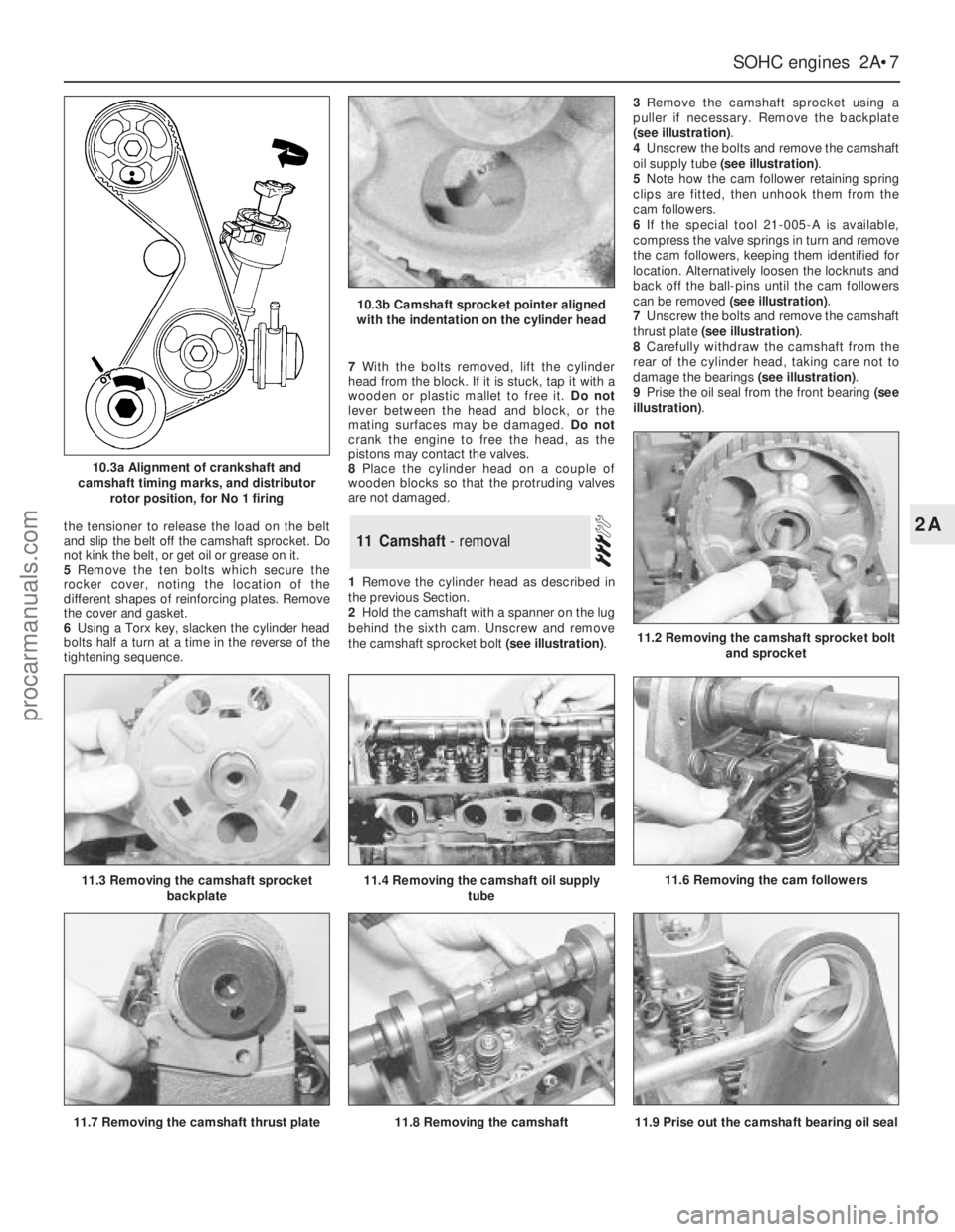
the tensioner to release the load on the belt
and slip the belt off the camshaft sprocket. Do
not kink the belt, or get oil or grease on it.
5Remove the ten bolts which secure the
rocker cover, noting the location of the
different shapes of reinforcing plates. Remove
the cover and gasket.
6Using a Torx key, slacken the cylinder head
bolts half a turn at a time in the reverse of the
tightening sequence.7With the bolts removed, lift the cylinder
head from the block. If it is stuck, tap it with a
wooden or plastic mallet to free it. Do not
lever between the head and block, or the
mating surfaces may be damaged. Do not
crank the engine to free the head, as the
pistons may contact the valves.
8Place the cylinder head on a couple of
wooden blocks so that the protruding valves
are not damaged.
1Remove the cylinder head as described in
the previous Section.
2Hold the camshaft with a spanner on the lug
behind the sixth cam. Unscrew and remove
the camshaft sprocket bolt (see illustration).3Remove the camshaft sprocket using a
puller if necessary. Remove the backplate
(see illustration).
4Unscrew the bolts and remove the camshaft
oil supply tube (see illustration).
5Note how the cam follower retaining spring
clips are fitted, then unhook them from the
cam followers.
6If the special tool 21-005-A is available,
compress the valve springs in turn and remove
the cam followers, keeping them identified for
location. Alternatively loosen the locknuts and
back off the ball-pins until the cam followers
can be removed (see illustration).
7Unscrew the bolts and remove the camshaft
thrust plate (see illustration).
8Carefully withdraw the camshaft from the
rear of the cylinder head, taking care not to
damage the bearings (see illustration).
9Prise the oil seal from the front bearing (see
illustration).11Camshaft - removal
SOHCengines 2A•7
2A
10.3a Alignment of crankshaft and
camshaft timing marks, and distributor
rotor position, for No 1 firing
10.3b Camshaft sprocket pointer aligned
with the indentation on the cylinder head
11.6 Removing the cam followers
11.2 Removing the camshaft sprocket bolt
and sprocket
11.3 Removing the camshaft sprocket
backplate11.4 Removing the camshaft oil supply
tube
11.9 Prise out the camshaft bearing oil seal11.7 Removing the camshaft thrust plate11.8 Removing the camshaft
procarmanuals.com
Page 31 of 255

1Remove the camshaft as described in the
previous Section. (If tool 21-005-A is available,
leave the camshaft in place until the valves
have been removed).
2Using a valve spring compressor, compress
each valve spring in turn until the split collets
can be removed. Release the compressor and
remove the cap and spring, keeping them
identified for location (see illustrations).
3Remove each valve from the cylinder head,
but identify them for location (see illustration).
4Prise the valve stem oil seals from the tops
of the valve guides (see illustration).
5If necessary unscrew the cam follower ball-
pins from the cylinder head, keeping them
identified for location.
6If necessary unscrew the bolts and remove
the timing belt tensioner.
7Remove the thermostat and housing.
8Remove the temperature gauge sender unit.
9Remove the manifold studs if wished by
locking two nuts onto each stud in turn and
unscrewing it.
1If the engine is still in the vehicle, carry out
the following preliminary operations:
a)Disconnect the battery negative lead
b)Remove the radiator and disconnect the
hose from the thermostat housing
c)Remove the accessory drivebelt(s)
2Unscrew the bolts and withdraw the timing
cover. Note the location of the cover in the
special bolt.
3Using a socket on the crankshaft pulley bolt,
turn the engine clockwise until the TDC (top
dead centre) notch on the pulley is alignedwith the pointer on the crankshaft front oil seal
housing, and the pointer on the camshaft
sprocket is aligned with the indentation on the
cylinder head. Note the position of the
distributor rotor arm. Mark the contact end of
the rotor in relation to the rim of the distributor
body.
4Slacken the timing belt tensioner retaining
bolts then pivot the tensioner pulley away from
the belt, to obtain maximum drivebelt free play
(see illustration). Hold the tensioner pulley in
this position and securely retighten the
retaining bolts.
5Mark the running direction of the belt if it is
to be re-used, then slip it off the camshaft
sprocket.
6Slacken the crankshaft pulley bolt. Prevent
the crankshaft from turning by engaging 5thgear (manual gearbox), or by removing the
starter motor and jamming the ring gear teeth.
Alternatively, if the pulley has peripheral bolt
holes, screw in a couple of bolts and use a
lever between them to jam it. Do not allow the
crankshaft to turn very far, or piston/valve
contact may occur.
7Remove the bolt and washer and withdraw
the pulley. If the pulley will not come off easily,
refit the bolt part way and use a puller (see
illustration). A puller will almost certainly be
required on fuel-injection models.
8Remove the guide washer from in front of
the crankshaft sprocket, then remove the
timing belt (see illustration). Do not kink it or
get oil on it if it is to be re-used.
9Remove the crankshaft sprocket using a
puller if necessary (see illustration).
13Timing belt and sprockets -
removal
12Cylinder head - dismantling
2A•8SOHCengines
12.2a Compressing a valve spring
13.4 Timing belt tensioner bolts (arrowed)13.7 Using a puller to remove the
crankshaft pulley
12.4 Removing a valve stem oil seal
13.8 Remove the guide washer from in
front of the crankshaft sprocket
12.2b Removing a valve spring and cap
12.3 Removing a valve
If the caps are difficult to
remove do not continue to
tighten the compressor, but
gently tap the top of the tool
with a hammer. Always ensure that the
compressor is held firmly over the cap.
procarmanuals.com
Page 32 of 255
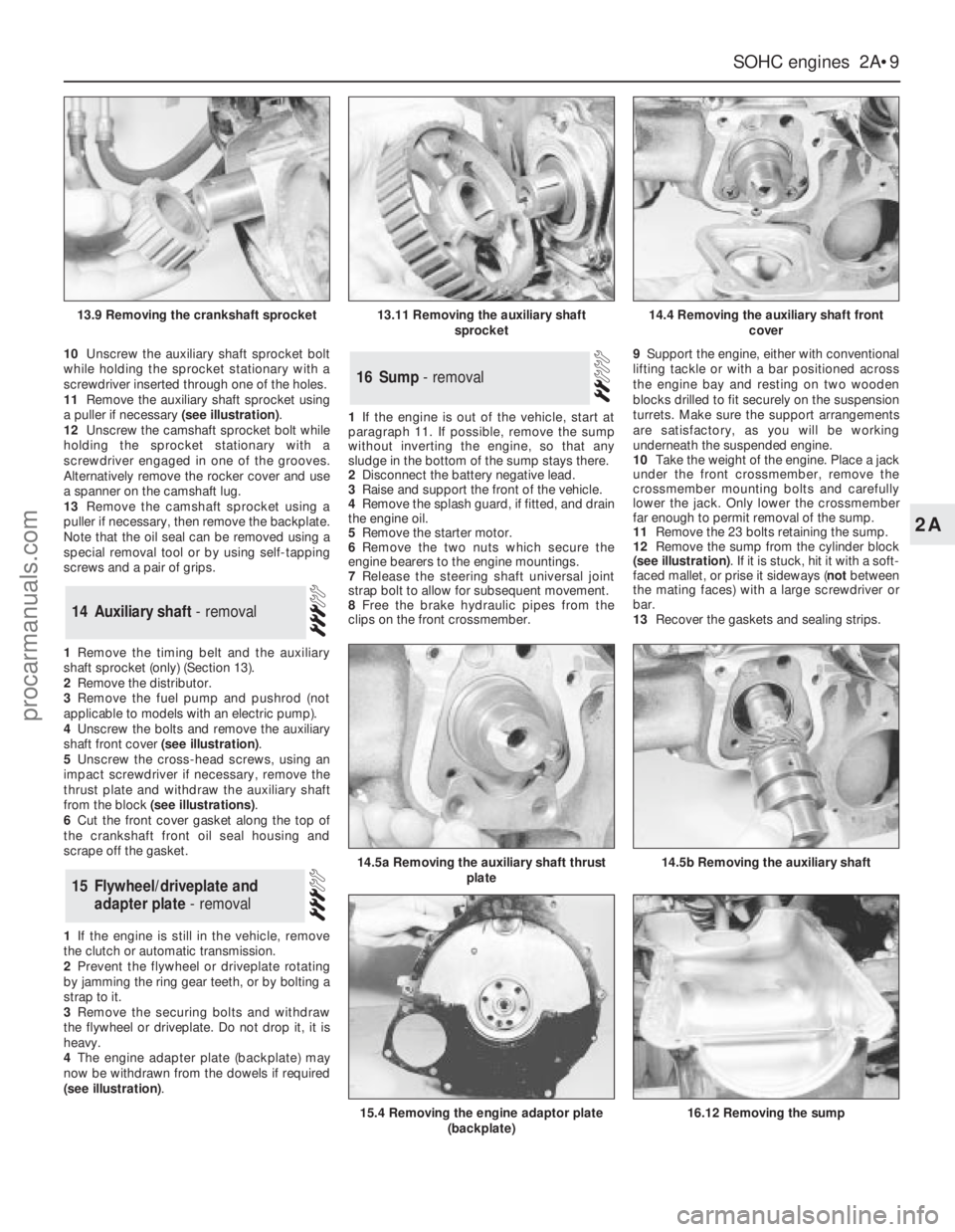
10Unscrew the auxiliary shaft sprocket bolt
while holding the sprocket stationary with a
screwdriver inserted through one of the holes.
11Remove the auxiliary shaft sprocket using
a puller if necessary (see illustration).
12Unscrew the camshaft sprocket bolt while
holding the sprocket stationary with a
screwdriver engaged in one of the grooves.
Alternatively remove the rocker cover and use
a spanner on the camshaft lug.
13Remove the camshaft sprocket using a
puller if necessary, then remove the backplate.
Note that the oil seal can be removed using a
special removal tool or by using self-tapping
screws and a pair of grips.
1Remove the timing belt and the auxiliary
shaft sprocket (only) (Section 13).
2Remove the distributor.
3Remove the fuel pump and pushrod (not
applicable to models with an electric pump).
4Unscrew the bolts and remove the auxiliary
shaft front cover (see illustration).
5Unscrew the cross-head screws, using an
impact screwdriver if necessary, remove the
thrust plate and withdraw the auxiliary shaft
from the block (see illustrations).
6Cut the front cover gasket along the top of
the crankshaft front oil seal housing and
scrape off the gasket.
1If the engine is still in the vehicle, remove
the clutch or automatic transmission.
2Prevent the flywheel or driveplate rotating
by jamming the ring gear teeth, or by bolting a
strap to it.
3Remove the securing bolts and withdraw
the flywheel or driveplate. Do not drop it, it is
heavy.
4The engine adapter plate (backplate) may
now be withdrawn from the dowels if required
(see illustration).1If the engine is out of the vehicle, start at
paragraph 11. If possible, remove the sump
without inverting the engine, so that any
sludge in the bottom of the sump stays there.
2Disconnect the battery negative lead.
3Raise and support the front of the vehicle.
4Remove the splash guard, if fitted, and drain
the engine oil.
5Remove the starter motor.
6Remove the two nuts which secure the
engine bearers to the engine mountings.
7Release the steering shaft universal joint
strap bolt to allow for subsequent movement.
8Free the brake hydraulic pipes from the
clips on the front crossmember.9Support the engine, either with conventional
lifting tackle or with a bar positioned across
the engine bay and resting on two wooden
blocks drilled to fit securely on the suspension
turrets. Make sure the support arrangements
are satisfactory, as you will be working
underneath the suspended engine.
10Take the weight of the engine. Place a jack
under the front crossmember, remove the
crossmember mounting bolts and carefully
lower the jack. Only lower the crossmember
far enough to permit removal of the sump.
11Remove the 23 bolts retaining the sump.
12Remove the sump from the cylinder block
(see illustration). If it is stuck, hit it with a soft-
faced mallet, or prise it sideways (notbetween
the mating faces) with a large screwdriver or
bar.
13Recover the gaskets and sealing strips.
16Sump - removal
15Flywheel/driveplate and
adapter plate - removal
14Auxiliary shaft - removal
SOHCengines 2A•9
2A
13.9 Removing the crankshaft sprocket13.11 Removing the auxiliary shaft
sprocket14.4 Removing the auxiliary shaft front
cover
14.5b Removing the auxiliary shaft14.5a Removing the auxiliary shaft thrust
plate
15.4 Removing the engine adaptor plate
(backplate)16.12 Removing the sump
procarmanuals.com
Page 33 of 255

1Remove the timing belt and the crankshaft
sprocket (only).
2If an oil seal removal tool is available. the oil
seal can be removed at this stage. It may also
be possible to remove the oil seal by drilling
the outer face and using self-tapping screws
and a pair of grips.
3If the oil seal cannot be removed as
described in paragraph 2, remove the sump.
Also remove the auxiliary shaft sprocket.
Unbolt the oil seal housing and auxiliary shaft
front cover and remove the gasket. The oil seal
can then be driven out from the inside (see
illustrations).
4Clean the oil seal seating, then drive in a
new seal using metal tubing or a suitable
socket (see illustration). Make sure that thesealing lip faces into the engine, and lightly oil
the lip.
5If applicable fit the oil seal housing and
auxiliary shaft front cover to the block together
with a new gasket and tighten the bolts. Make
sure that the bottom face of the housing is
aligned with the bottom face of the block (see
illustrations). Fit the sump.
6Refit the timing belt and sprockets.
1Remove the flywheel or driveplate and the
engine adapter plate (backplate).
2Using a special removal tool extract the oil
seal (see illustration).However it may be
possible to remove the oil seal by drilling the
outer face and using self-tapping screws and
a pair of grips.3Clean the oil seal seating, then drive in a
new seal using a suitable metal tube. Make
sure that the sealing lip faces into the engine,
and lightly oil the lip.
4Refit the adapter plate and the
flywheel/driveplate.
1Remove the sump.
2Unscrew the bolt securing the pick-up tube
and strainer to the block (see illustration).
3Using a special splined key, unscrew the
bolts and withdraw the oil pump and strainer
(see illustration).
4Withdraw the hexagon shaped driveshaft
which engages the bottom of the distributor,
noting which way round it is fitted (see
illustration).
19Oil pump - removal
18Crankshaft rear oil seal -
renewal
17Crankshaft front oil seal -
renewal
2A•10SOHCengines
17.3a Removing the crankshaft front oil
seal housing
19.2 Unbolting the oil pump pick-up
strainer from the block19.3 Removing the splined bolts which
secure the oil pump19.4 Removing the oil pump driveshaft
18.2 Using an oil seal removal tool to
extract the crankshaft rear oil seal
17.3b Driving the oil seal out of the housing
17.5a Oil seal housing and auxiliary shaft
cover gasket in position17.5b Checking the alignment of the front
oil seal housing
17.4 Using a socket and a hammer to seat
the new seal
procarmanuals.com
Page 34 of 255
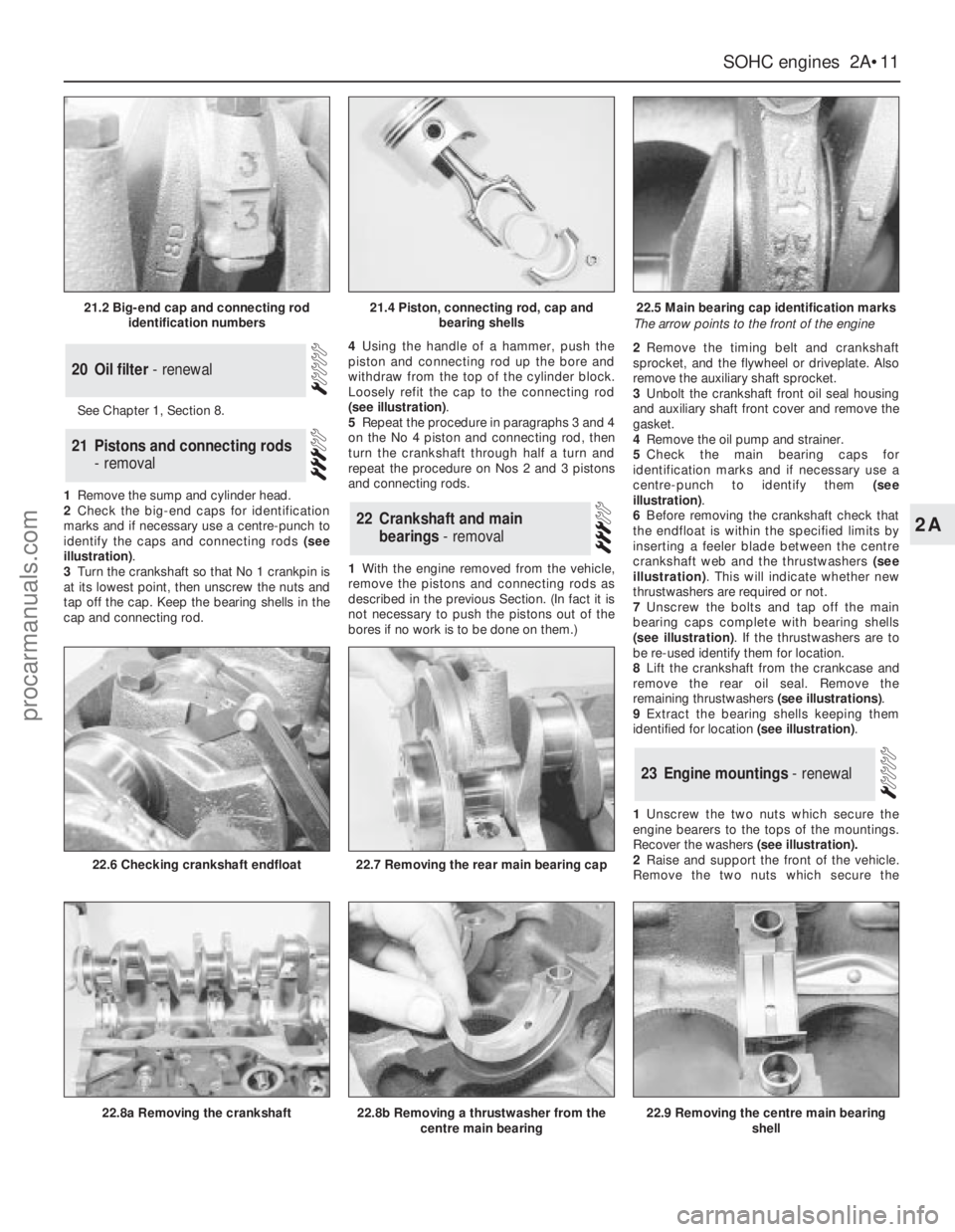
See Chapter 1, Section 8.
1Remove the sump and cylinder head.
2Check the big-end caps for identification
marks and if necessary use a centre-punch to
identify the caps and connecting rods (see
illustration).
3Turn the crankshaft so that No 1 crankpin is
at its lowest point, then unscrew the nuts and
tap off the cap. Keep the bearing shells in the
cap and connecting rod.4Using the handle of a hammer, push the
piston and connecting rod up the bore and
withdraw from the top of the cylinder block.
Loosely refit the cap to the connecting rod
(see illustration).
5Repeat the procedure in paragraphs 3 and 4
on the No 4 piston and connecting rod, then
turn the crankshaft through half a turn and
repeat the procedure on Nos 2 and 3 pistons
and connecting rods.
1With the engine removed from the vehicle,
remove the pistons and connecting rods as
described in the previous Section. (In fact it is
not necessary to push the pistons out of the
bores if no work is to be done on them.)2Remove the timing belt and crankshaft
sprocket, and the flywheel or driveplate. Also
remove the auxiliary shaft sprocket.
3Unbolt the crankshaft front oil seal housing
and auxiliary shaft front cover and remove the
gasket.
4Remove the oil pump and strainer.
5Check the main bearing caps for
identification marks and if necessary use a
centre-punch to identify them (see
illustration).
6Before removing the crankshaft check that
the endfloat is within the specified limits by
inserting a feeler blade between the centre
crankshaft web and the thrustwashers (see
illustration). This will indicate whether new
thrustwashers are required or not.
7Unscrew the bolts and tap off the main
bearing caps complete with bearing shells
(see illustration). If the thrustwashers are to
be re-used identify them for location.
8Lift the crankshaft from the crankcase and
remove the rear oil seal. Remove the
remaining thrustwashers (see illustrations).
9Extract the bearing shells keeping them
identified for location (see illustration).
1Unscrew the two nuts which secure the
engine bearers to the tops of the mountings.
Recover the washers(see illustration).
2Raise and support the front of the vehicle.
Remove the two nuts which secure the
23Engine mountings - renewal
22Crankshaft and main
bearings - removal
21Pistons and connecting rods
- removal
20Oil filter - renewal
SOHCengines 2A•11
2A
21.2 Big-end cap and connecting rod
identification numbers21.4 Piston, connecting rod, cap and
bearing shells22.5 Main bearing cap identification marks
The arrow points to the front of the engine
22.8a Removing the crankshaft
22.6 Checking crankshaft endfloat
22.8b Removing a thrustwasher from the
centre main bearing
22.7 Removing the rear main bearing cap
22.9 Removing the centre main bearing
shell
procarmanuals.com
Page 35 of 255
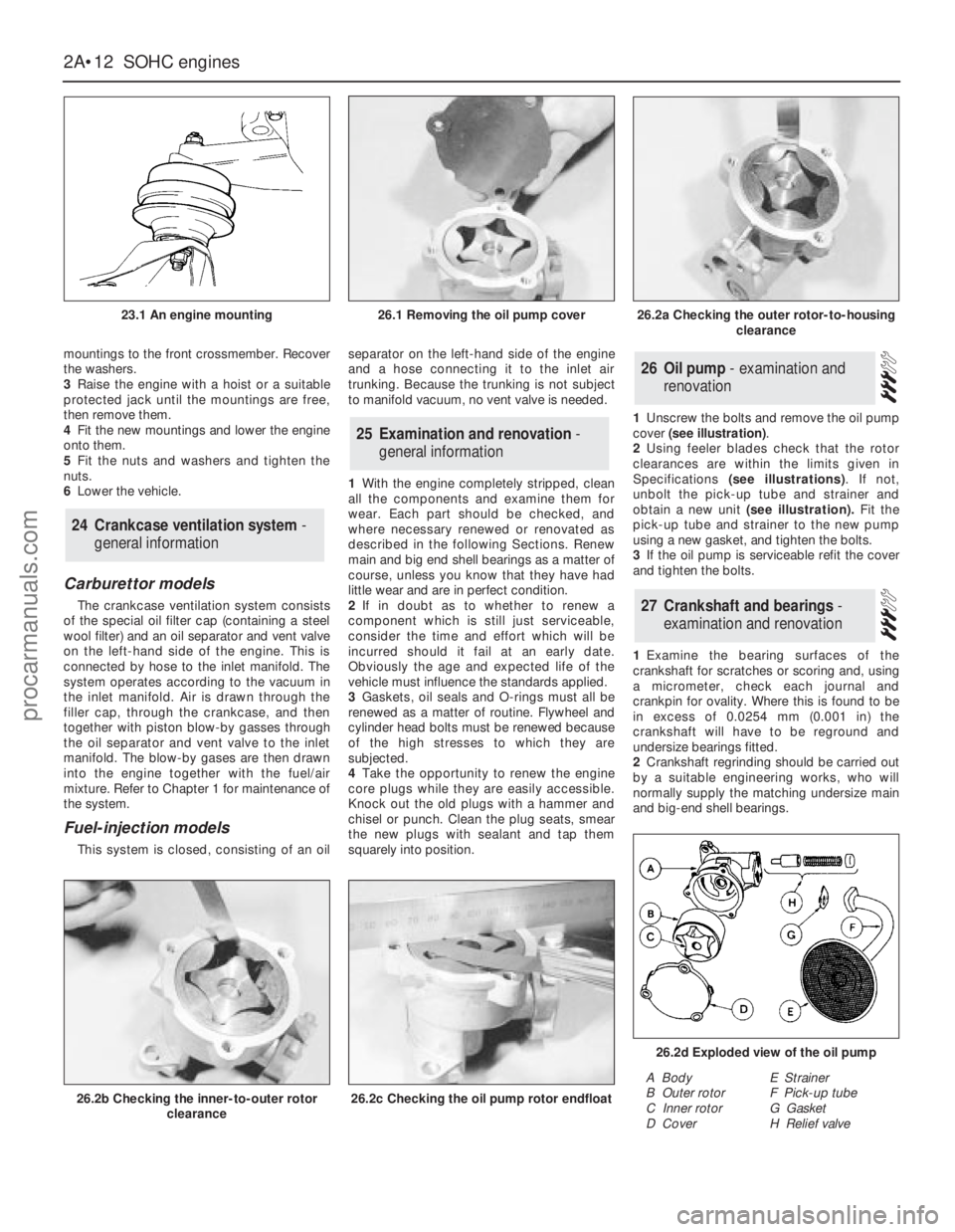
mountings to the front crossmember. Recover
the washers.
3Raise the engine with a hoist or a suitable
protected jack until the mountings are free,
then remove them.
4Fit the new mountings and lower the engine
onto them.
5Fit the nuts and washers and tighten the
nuts.
6Lower the vehicle.
Carburettor models
The crankcase ventilation system consists
of the special oil filter cap (containing a steel
wool filter) and an oil separator and vent valve
on the left-hand side of the engine. This is
connected by hose to the inlet manifold. The
system operates according to the vacuum in
the inlet manifold. Air is drawn through the
filler cap, through the crankcase, and then
together with piston blow-by gasses through
the oil separator and vent valve to the inlet
manifold. The blow-by gases are then drawn
into the engine together with the fuel/air
mixture. Refer to Chapter 1 for maintenance of
the system.
Fuel-injection models
This system is closed, consisting of an oilseparator on the left-hand side of the engine
and a hose connecting it to the inlet air
trunking. Because the trunking is not subject
to manifold vacuum, no vent valve is needed.
1With the engine completely stripped, clean
all the components and examine them for
wear. Each part should be checked, and
where necessary renewed or renovated as
described in the following Sections. Renew
main and big end shell bearings as a matter of
course, unless you know that they have had
little wear and are in perfect condition.
2If in doubt as to whether to renew a
component which is still just serviceable,
consider the time and effort which will be
incurred should it fail at an early date.
Obviously the age and expected life of the
vehicle must influence the standards applied.
3Gaskets, oil seals and O-rings must all be
renewed as a matter of routine. Flywheel and
cylinder head bolts must be renewed because
of the high stresses to which they are
subjected.
4Take the opportunity to renew the engine
core plugs while they are easily accessible.
Knock out the old plugs with a hammer and
chisel or punch. Clean the plug seats, smear
the new plugs with sealant and tap them
squarely into position.1Unscrew the bolts and remove the oil pump
cover (see illustration).
2Using feeler blades check that the rotor
clearances are within the limits given in
Specifications (see illustrations). If not,
unbolt the pick-up tube and strainer and
obtain a new unit (see illustration).Fit the
pick-up tube and strainer to the new pump
using a new gasket, and tighten the bolts.
3If the oil pump is serviceable refit the cover
and tighten the bolts.
1Examine the bearing surfaces of the
crankshaft for scratches or scoring and, using
a micrometer, check each journal and
crankpin for ovality. Where this is found to be
in excess of 0.0254 mm (0.001 in) the
crankshaft will have to be reground and
undersize bearings fitted.
2Crankshaft regrinding should be carried out
by a suitable engineering works, who will
normally supply the matching undersize main
and big-end shell bearings.
27Crankshaft and bearings -
examination and renovation
26Oil pump - examination and
renovation
25Examination and renovation -
general information
24Crankcase ventilation system -
general information
2A•12SOHCengines
23.1 An engine mounting
26.2b Checking the inner-to-outer rotor
clearance26.2c Checking the oil pump rotor endfloat
26.2d Exploded view of the oil pump
A Body
B Outer rotor
C Inner rotor
D CoverE Strainer
F Pick-up tube
G Gasket
H Relief valve
26.1 Removing the oil pump cover26.2a Checking the outer rotor-to-housing
clearance
procarmanuals.com
Page 36 of 255
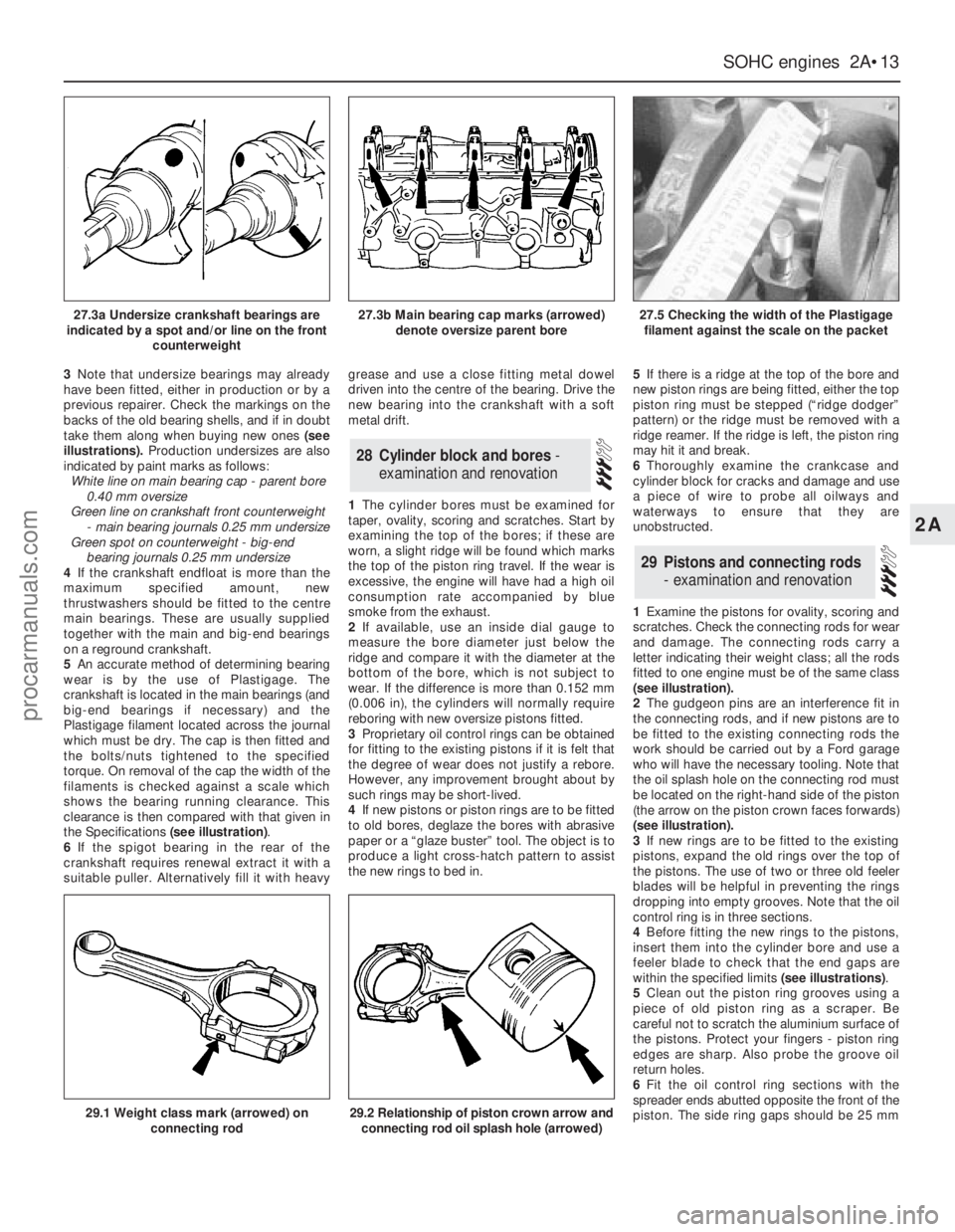
3Note that undersize bearings may already
have been fitted, either in production or by a
previous repairer. Check the markings on the
backs of the old bearing shells, and if in doubt
take them along when buying new ones(see
illustrations).Production undersizes are also
indicated by paint marks as follows:
White line on main bearing cap - parent bore
0.40 mm oversize
Green line on crankshaft front counterweight
- main bearing journals 0.25 mm undersize
Green spot on counterweight - big-end
bearing journals 0.25 mm undersize
4If the crankshaft endfloat is more than the
maximum specified amount, new
thrustwashers should be fitted to the centre
main bearings. These are usually supplied
together with the main and big-end bearings
on a reground crankshaft.
5An accurate method of determining bearing
wear is by the use of Plastigage. The
crankshaft is located in the main bearings (and
big-end bearings if necessary) and the
Plastigage filament located across the journal
which must be dry. The cap is then fitted and
the bolts/nuts tightened to the specified
torque. On removal of the cap the width of the
filaments is checked against a scale which
shows the bearing running clearance. This
clearance is then compared with that given in
the Specifications (see illustration).
6If the spigot bearing in the rear of the
crankshaft requires renewal extract it with a
suitable puller. Alternatively fill it with heavygrease and use a close fitting metal dowel
driven into the centre of the bearing. Drive the
new bearing into the crankshaft with a soft
metal drift.
1The cylinder bores must be examined for
taper, ovality, scoring and scratches. Start by
examining the top of the bores; if these are
worn, a slight ridge will be found which marks
the top of the piston ring travel. If the wear is
excessive, the engine will have had a high oil
consumption rate accompanied by blue
smoke from the exhaust.
2If available, use an inside dial gauge to
measure the bore diameter just below the
ridge and compare it with the diameter at the
bottom of the bore, which is not subject to
wear. If the difference is more than 0.152 mm
(0.006 in), the cylinders will normally require
reboring with new oversize pistons fitted.
3Proprietary oil control rings can be obtained
for fitting to the existing pistons if it is felt that
the degree of wear does not justify a rebore.
However, any improvement brought about by
such rings may be short-lived.
4If new pistons or piston rings are to be fitted
to old bores, deglaze the bores with abrasive
paper or a “glaze buster” tool. The object is to
produce a light cross-hatch pattern to assist
the new rings to bed in. 5If there is a ridge at the top of the bore and
new piston rings are being fitted, either the top
piston ring must be stepped (“ridge dodger”
pattern) or the ridge must be removed with a
ridge reamer. If the ridge is left, the piston ring
may hit it and break.
6Thoroughly examine the crankcase and
cylinder block for cracks and damage and use
a piece of wire to probe all oilways and
waterways to ensure that they are
unobstructed.
1Examine the pistons for ovality, scoring and
scratches. Check the connecting rods for wear
and damage. The connecting rods carry a
letter indicating their weight class; all the rods
fitted to one engine must be of the same class
(see illustration).
2The gudgeon pins are an interference fit in
the connecting rods, and if new pistons are to
be fitted to the existing connecting rods the
work should be carried out by a Ford garage
who will have the necessary tooling. Note that
the oil splash hole on the connecting rod must
be located on the right-hand side of the piston
(the arrow on the piston crown faces forwards)
(see illustration).
3If new rings are to be fitted to the existing
pistons, expand the old rings over the top of
the pistons. The use of two or three old feeler
blades will be helpful in preventing the rings
dropping into empty grooves. Note that the oil
control ring is in three sections.
4Before fitting the new rings to the pistons,
insert them into the cylinder bore and use a
feeler blade to check that the end gaps are
within the specified limits (see illustrations).
5Clean out the piston ring grooves using a
piece of old piston ring as a scraper. Be
careful not to scratch the aluminium surface of
the pistons. Protect your fingers - piston ring
edges are sharp. Also probe the groove oil
return holes.
6Fit the oil control ring sections with the
spreader ends abutted opposite the front of the
piston. The side ring gaps should be 25 mm
29Pistons and connecting rods
- examination and renovation
28Cylinder block and bores -
examination and renovation
SOHCengines 2A•13
2A
27.3a Undersize crankshaft bearings are
indicated by a spot and/or line on the front
counterweight27.3b Main bearing cap marks (arrowed)
denote oversize parent bore27.5 Checking the width of the Plastigage
filament against the scale on the packet
29.1 Weight class mark (arrowed) on
connecting rod29.2 Relationship of piston crown arrow and
connecting rod oil splash hole (arrowed)
procarmanuals.com